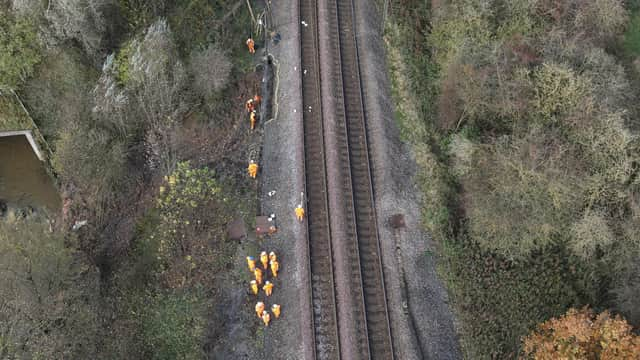Network Rail to spend £22m on East Coast mainline to tackle effects of climate change


Over the past year, there have been multiple incidents of landslips and flooding along the East Coast route, including at Aycliffe, near Darlington, as well as between Newark and Grantham, causing major disruption to passengers and communities.
Network Rail has announced a massive investment programme over the coming years to improve resilience in the network due to the effects of extreme weather caused by climate change. These incidents are seen as potentially be dangerous as well as expensive and time consuming to resolve.
Advertisement
Hide AdAdvertisement
Hide AdApril marks the start of Network Rail’s latest five-year cycle of spending and £22m is earmarked for investment to improve drainage on the East Coast route to help prevent incidents.
The funding will allow renewal and refurbishment projects to be proactively carried out on earthworks along the route, along with an enhanced monitoring and maintenance programme of drainage systems.
Paul Rutter, Route Director for Network Rail’s East Coast route, said: “Over the next five years, we are committed to making the rail network across our route better for all our passengers.
“Climate change is an ever-increasing problem for our aging infrastructure, but we are proactively working to tackle the issue and improve the reliability and resilience of our network.
Advertisement
Hide AdAdvertisement
Hide Ad“We will also be carrying out major improvements to track, switches and crossings, the equipment used for trains to cross from one track to another, signals, level crossings, and more to improve train performance and increase reliability for passengers."
Proactive climate-resilience work is currently taking place at Browney Curve near Durham, where Network Rail engineers are working to stabilise over 1km of land next to the East Coast Main Line.
One-in-three Britons live within 20 minutes of an East Coast station. The route serves 66 locations including major East Coast Main Line hubs at King’s Cross, York, and Newcastle, as well as commuter stations including Biggleswade, Royston, and Chester-Le-Street.
Over the next five years, the route will spend £2.8bn on the day-to-today running of the railway and a widespread programme of renewals and upgrades on the network, improving the experience of passengers as they travel by train.
Advertisement
Hide AdAdvertisement
Hide AdThe route will see £285m spent on the East Coast Digital Programme upgrading the southern end of the East Coast Main Line to digital signalling, leading to more reliable and greener journeys for passengers, as well as hundreds of kilometres of track renewed to enhance safety and network resilience.
Nationally, Network Rail has announced the start of its £45.4bn rail improvement plan aimed at delivering a simpler, better, greener railway, with major plans to tackle the extremes of climate change.
